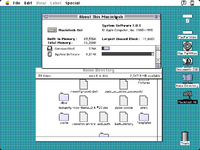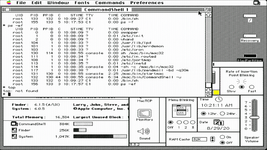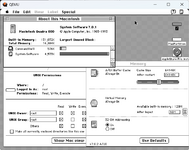posixcompliant
Member
Hello, *NIX friends!
I have a IIsi that I'm trying to get set up with A/UX. This is my first earnest attempt running A/UX on hardware, so I'll preface this all by saying that it's possible I'm missing something obvious. I'm using the "AUX_3_1_1GB_Use_In_Shoebill" image from this page with my BlueSCSI.
My machine will boot into System 7 just fine, and then starts running the A/UX loader. While the progress bar is going, it will briefly display "Launching..." before cutting to a full grey screen, after which the system seems to hang up. In looking at screen captures of other folks booting A/UX, there appears to be a brief flash of the same grey screen there before proceeding through the rest of the stages in the loading screen, but never anything that lasts more than a split-second from what I've seen.
This same IIsi is running vanilla System 7.0.1 without issue. Removing the network card and attempting to boot A/UX will throw a different error about not having an FPU, so this doesn't seem to be the result of a badly-seated FPU or network card. Testing this also allowed me to confirm that if I error out of the A/UX boot process without an FPU, I'm able to use the 7.0.1 boot system from that Use_In_Shoebill image as-normal.
I'm using the BMOW sync-inator for video output to a VGA monitor, but my understanding is that it only adjusts sync signals and shouldn't really impact the actual video signal, so I don't think that it's hitting some weird state where it's proceeding through the boot process but no longer displaying, although I don't have any way of confirming this with another display method at the moment.
Anyway, if anyway A/UX experts have thoughts on this, I'm all ears! Especially curious to hear from anyone who regularly uses A/UX with a IIsi in case there are any known config gotchas for that machine. Closer than I've ever been yet still so far away :')
I have a IIsi that I'm trying to get set up with A/UX. This is my first earnest attempt running A/UX on hardware, so I'll preface this all by saying that it's possible I'm missing something obvious. I'm using the "AUX_3_1_1GB_Use_In_Shoebill" image from this page with my BlueSCSI.
My machine will boot into System 7 just fine, and then starts running the A/UX loader. While the progress bar is going, it will briefly display "Launching..." before cutting to a full grey screen, after which the system seems to hang up. In looking at screen captures of other folks booting A/UX, there appears to be a brief flash of the same grey screen there before proceeding through the rest of the stages in the loading screen, but never anything that lasts more than a split-second from what I've seen.
This same IIsi is running vanilla System 7.0.1 without issue. Removing the network card and attempting to boot A/UX will throw a different error about not having an FPU, so this doesn't seem to be the result of a badly-seated FPU or network card. Testing this also allowed me to confirm that if I error out of the A/UX boot process without an FPU, I'm able to use the 7.0.1 boot system from that Use_In_Shoebill image as-normal.
I'm using the BMOW sync-inator for video output to a VGA monitor, but my understanding is that it only adjusts sync signals and shouldn't really impact the actual video signal, so I don't think that it's hitting some weird state where it's proceeding through the boot process but no longer displaying, although I don't have any way of confirming this with another display method at the moment.
Anyway, if anyway A/UX experts have thoughts on this, I'm all ears! Especially curious to hear from anyone who regularly uses A/UX with a IIsi in case there are any known config gotchas for that machine. Closer than I've ever been yet still so far away :')



